http://www.houzz.com/ideabooks/672823/list/How-to-Arrange-Furniture-in-Long--Narrow-Spaces
Is your room so long and narrow that when you walk in you start looking for black balls with 3 holes in them and suddenly get the urge to wear tacky shoes with a big size number on the back? Hey, bowling alleys are great! They are one of the few places where I can chew bubble gum and blow giant bubbles without the slightest embarrassment.
Well, unless you love the ambience of a bowling alley, the following tips for furniture arrangement in long, narrow spaces will give you rooms that are functional and don't look like a tunnel.
1. Keep the foot traffic to one side. One of the main difficulties in arranging furniture for a long, narrow room is where to have people walk through. The number one thing to avoid is sending your foot traffic between a seating piece and the coffee table in front of it.
This condo's main living areas are one long rectangle with tall ceilings that made it feel even more narrow. You can see that there is a French door to the patio on one end ....
by Pangaea Interior Design, Portland, OR This condo's main living areas are one long rectangle with tall ceilings that made it feel even more narrow. You can see that there is a French door to the patio on one end ....

... and looking the other direction you can see that the front door is at the opposite end. So we kept our furnishings over to one side of the room to allow the foot traffic to move in a straight line between the furniture and the fireplace. The ottoman is close to the sofa so people can put their feet up. That, combined with the L-shaped sectional, prevents anyone from trying to pass through the room between the sofa and ottoman.
Tip: Make sure any area rugs are placed so that you either walk over them or can stay completely off. In the room above, the open space on the area rug is wide enough to let people walk right across it. The hearth is flush into the floor, so you can also stay off the carpet and walk through without crossing the carpet.
It is really annoying to have a rug hit halfway into a pass-through area so that you need to walk through with one foot on and one foot off the rug. If you need a custom size to achieve this, an affordable solution is to buy one you like and have it cut down and bound.
by Pangaea Interior Design, Portland, OR Tip: Make sure any area rugs are placed so that you either walk over them or can stay completely off. In the room above, the open space on the area rug is wide enough to let people walk right across it. The hearth is flush into the floor, so you can also stay off the carpet and walk through without crossing the carpet.
It is really annoying to have a rug hit halfway into a pass-through area so that you need to walk through with one foot on and one foot off the rug. If you need a custom size to achieve this, an affordable solution is to buy one you like and have it cut down and bound.
This room uses the same principle, but this time the furniture faces away from the pass-through area. You need a little wider room to do this. Keeping an open space to one side of the room effectively creates a hallway with the living areas to one side.
by Chelsea Atelier Architect, PC 2. Place furniture in a corner arrangement with the foot traffic angling across open space. In this living room, the door opens right into one side, and a console table keeps you from walking straight down that side. But because the furniture has been placed in a nice conversational grouping in one corner, people can easily walk through the room past the furniture at an angle across the carpet.
They were wise to avoid trying to put another chair in here, which would have made the pass-through too tight a squeeze. The screen in the corner is also a nice touch in a narrow space because it visually changes the shape of the room a bit, rounding out the corner.
Tip: Just say "no" to too many pieces of furniture. We are often tempted to cram in an extra chair for the maximum seating, even when we only have guests a very small percentage of the time. Instead, consider double-duty pieces like the ottoman in the above photo which can work as seating when extra people are there.
by Jace Interiors & CreateGirl Blog They were wise to avoid trying to put another chair in here, which would have made the pass-through too tight a squeeze. The screen in the corner is also a nice touch in a narrow space because it visually changes the shape of the room a bit, rounding out the corner.
Tip: Just say "no" to too many pieces of furniture. We are often tempted to cram in an extra chair for the maximum seating, even when we only have guests a very small percentage of the time. Instead, consider double-duty pieces like the ottoman in the above photo which can work as seating when extra people are there.

3. Place some furniture perpendicular to the length of the room. In this room, if they had placed a long sofa facing the fireplace, by the time you put a coffee table in front of it, you would have to walk right through the sitting area to get by. Plus, the room would have looked longer and skinnier! By using loveseats instead of a longer sofa, they were able to place them perpendicular to the length of the room with space left for a pass-through area down the side of the room. I know wide-angle lenses used for professional photos make rooms look nice and big. But based on the furnishings, I estimate that this room is not more than 12 feet wide.
by Nicholas Moriarty Interiors 
Judging from the loveseat at the end of the room, I bet you this room is also about 12 feet wide. That little loveseat across the end of the room helps to stop the eye. Without the loveseat in front of the big window, it would feel like the room just didn't stop, exaggerating the long, skinny feel.
by Jennifer Brouwer 4. Put some furniture on an angle. To reduce the feeling of tunnel vision, try an arrangement with some of your furniture on an angle. By most people's standards, this isn't a terribly narrow room. But it is much longer than it is wide, so it could easily get that bowling-alley look with the wrong furniture arrangement. Here they actually had room to put their entire sectional on an angle, breaking up the long straight lines of the room.
by David Vandervort Architects This narrow room is used by my client as a TV room. They also wanted a small home office space where they could work on their laptop and some papers.
Fortunately, the doorway into the room is in the middle of one side, so we didn't have to allow for foot traffic through the room. We placed a sectional in this end with the TV.
by Pangaea Interior Design, Portland, OR Fortunately, the doorway into the room is in the middle of one side, so we didn't have to allow for foot traffic through the room. We placed a sectional in this end with the TV.

On the other end of this room we placed a small writing desk and angled just the desk. It keeps the room from feeling quite as long and also that angle helps to define a separate functional area. I like that the desk faces in to the room — I hate desks that face the wall, don't you? I feel like I'm being punished if I have to sit facing the wall.
by Pangaea Interior Design, Portland, OR 
Placing a long sofa facing the fireplace wouldn't have done much to break up the bowling alley feel in this long room. The arrangement of four angled chairs makes this end of the room feel wider.
by Architects Magnus 5. Circular coffee tables and dining tables work well. In this long room accommodating a sitting room and dining room, the circular coffee table and dining table both help to counteract the linear feeling you can get in narrow spaces.
by Lea Frank Design 
6. Narrower options for coffee tables are good too. Sometimes you don't have room for a round coffee table. This long rectangular ottoman works perfectly in a narrow space and is soft, so you won't bang your shins.
by Rachel Reider Interiors Small stools, cubes or chow tables are perfect as options for coffee tables in narrow spaces. Notice that they also used a loveseat and chaise facing each other and perpendicular to the length of the room similar to photo No. 5. This is a very compact furniture arrangement that would work in all types of small spaces.
by Niche Interiors 7. Use the upper part of your walls to allow maximum floor space for furniture. Creating bookshelves up high on this wall instead of having a bookcase standing on the floor allows the daybed to be placed next to the wall. The shelves are high enough so you don't bang your head when sitting down.
by Stacie Velten 
If you need free-standing storage pieces, placing them at the end of the room keeps it from looking narrower. Notice that again you are seeing the seating pieces placed perpendicular to the length of the room.
Let me know how you dealt with your long, skinny room and put up those photos below!
Let me know how you dealt with your long, skinny room and put up those photos below!

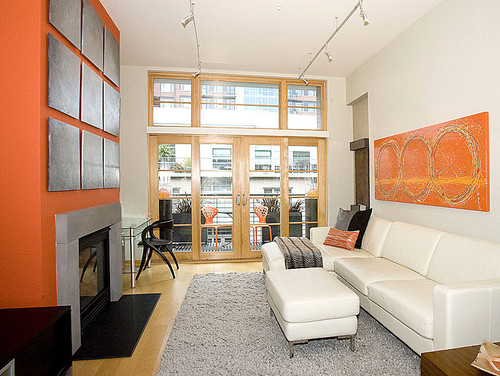
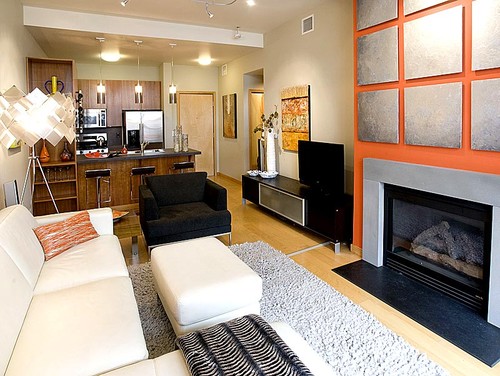
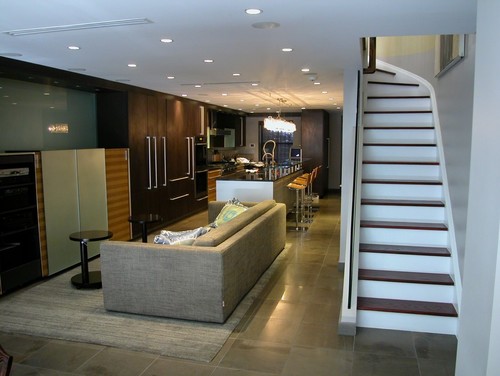
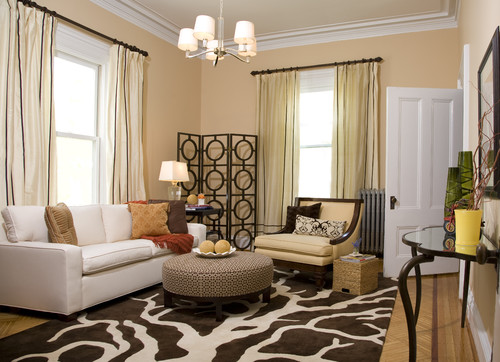
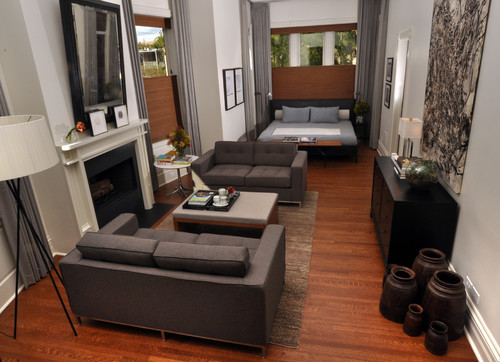
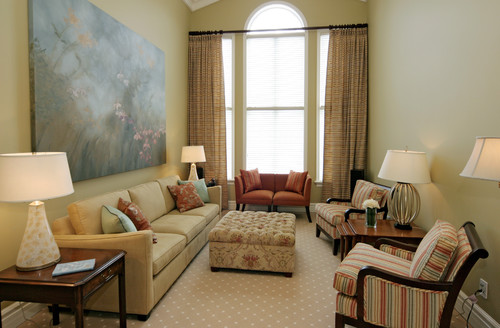
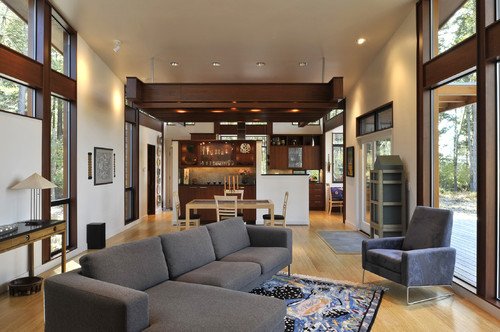
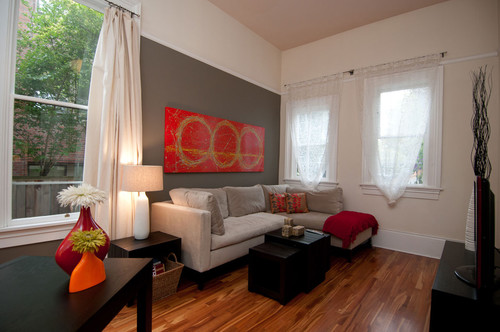
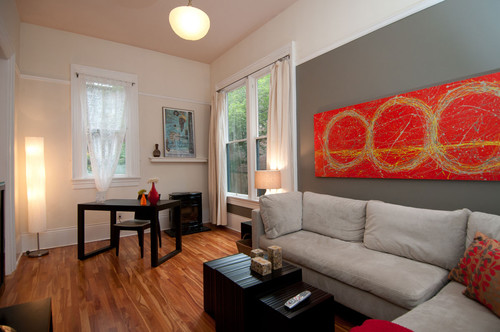
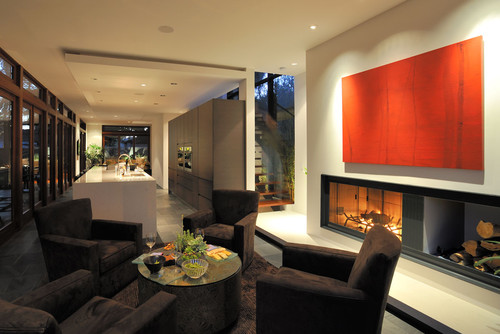
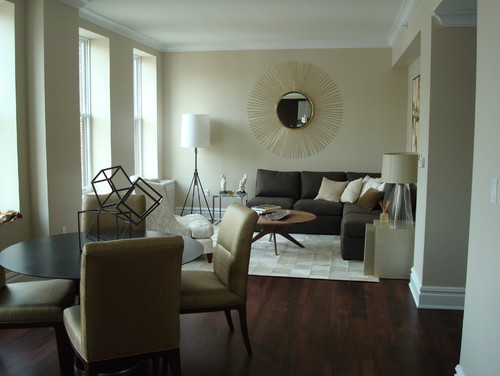
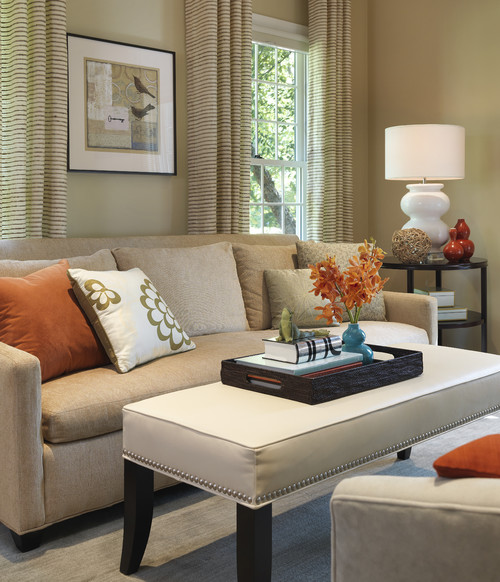
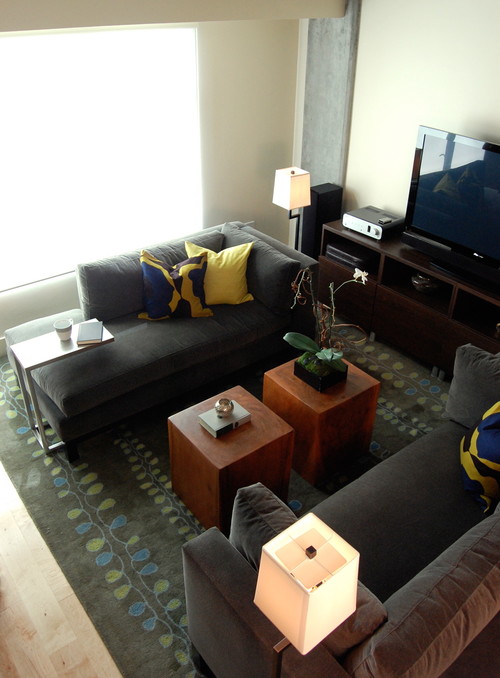
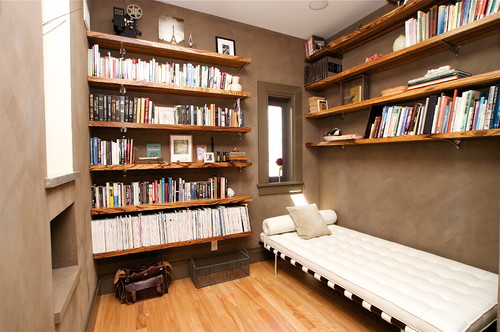
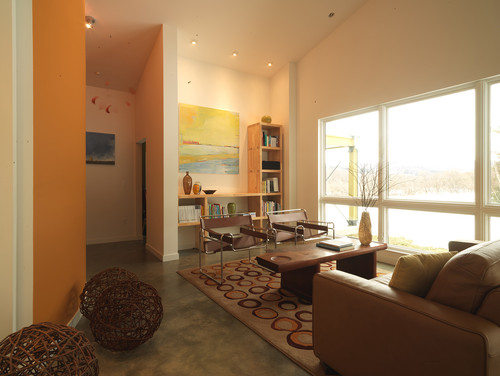
No comments:
Post a Comment